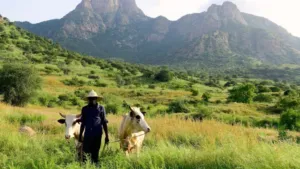Drylands cover roughly 40 percent of the planet’s land surface. The deserts at their core are surrounded by wide expanses of savanna grass, dry woodlands, and sometimes irrigated fields. They are home to more than a third of the world’s population and are among the most biodiverse ecosystems in the world, according to the International Union for Conservation of Nature, the international organization for conservation scientists.
Over the past half-century, most drylands have been experiencing a decline in rainfall, along with higher temperatures and greater rates of evaporation. Many have also been degraded by poor farming practices and overgrazing of livestock. Climate scientists and ecologists alike have until recently presumed that this combination of growing meteorological aridity and pressure from human activities would lead to less vegetation. They have routinely warned of widespread desertification, which U.N. officials have called “the greatest environmental challenge of our time.”
